Report from Autosport of 19th October 1978
Long distance runner
Pentti's Chevette holds off Escorts - Sensational drives by Malcolm Wilson and graham Elsmore - Terry Kaby wins G1 and finishes fifth overall - Tyre choice proves vital on long stages - Wilson now leads Castrol/Autosport championship -
Report: RUPERT SAUNDERS - Photography: TONY NORTH
In the mountains of Wales, the grey, damp fog seems to swirl incessantly round the tree-tops, hiding one bend, revealing another; sliding from one peak to the next. The old lead mining town of Dylife is now a ghost village. A desert area of crumbling buildings and disused shafts. The mountains artificially manufactured from the waste of the mine workings. And yet the fog reveals life here still. Through the swirl of time, as if the ghosts of miners themselves have returned, the village comes to life again.
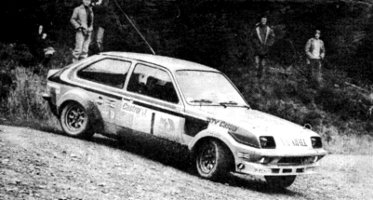
"For the second year running Pentti Airikkala proved to be the master of the long forest stages."
Each little house has its allotted area, many have some means of preparing food and water, some even have modern entertainment. Outside each house the menfolk gather in little knots to talk the day away. To wait and watch for the arrival of the God whom they all obey and for whom they work. The Castrol 78 Rally and its service centre has indeed brought life to Dylife once more. The fog also serves as a ghostly reminder of the unknowns of rallying. Nothing is certain. In a struggle between two of the Gods of rallying, there is more than just driving skill involved. There are all the technicalities of the sport. Tyres, tuning, service crews and luck. This year's Castrol 78 Rally, round nine of the Castrol/Autosport championship, brought all these factors into play. From them can emerge only one winner and, for the second year running one this event, it was Pentti Airikkala. Last year a puncture gave Pentti victory, this year tyres again played a part. But it wasn't only tyres. Pentti and the Escort driver Ari Vatanen had been battling all day. Both made mistakes and both had their lucky breaks. The rally brought with if outstanding drives from both Malcolm Wilson and Graham Elsmore, Malcolm taking The Castrol National Rally, organised by Wolverhampton and South Staffs Car Club, continues to grow in stature and this year could quite justifiably claim to be the second most important rally in the British Isles. What other rally, national or international, could boast of an involvement of five factory backed teams, of such drivers as Bjorn Waldegaard, Jean-Luc Therier and Pentti Airikkala? Whether they come for some pre-RAC testing or whether they come for the superb, long stages is a matter for conjecture; the fact is that they do come.the lead of the Castrol/Autosport championship as a result of his third place overall. With only one round to go, Malcolm now has a four point advantage on Jim McRae who finished eighth. In a hard fought G1 category Terry Kaby had a sensational drive into fifth place overall beating many, much, more powerful cars with his Dolomite Sprint.

The Castrol National Rally, organised by Wolverhampton and South Staffs Car Club, continues to grow in stature and this year could quite justifiably claim to be the second most important rally in the British Isles. What other rally, national or international, could boast of an involvement of five factory backed teams, of such drivers as Bjorn Waldegaard, Jean-Luc Therier and Pentti Airikkala? Whether they come for some pre-RAC testing or whether they come for the superb, long stages is a matter for conjecture; the fact is that they do come.
This year the rally consisted of just seven stages with the heart of the action once again in the Hafren complex. Two runs through Hafren, both from south to north but one with an added loop, made up almost 50% of the competitive mileage which incidentally, totalled just under 100 miles. In addition to Hafren, there was a run of Pantperthog, the familiar two stages in Dyfi, one to the north and one to the south, and two runs over Ystwyth. All the stages were in prime condition and the damp conditions which prevailed through-out the event meant that the surfaces were very slippery indeed. The choice of tyres was to prove crucial to the overall result.
These particular forests are vital to the future of rallying in mid-Wales and it would seem that problems in obtaining them are on the increase. Ystwyth already has a public relations problem and it would surely be a tragedy if Hafren itself was lost. Although this particular forest is fairly remote from any inhabitation, there are still problems arising. For these reasons, spectators on the event and the service crews of competitors were kept very strictly under control. Spectators were given locations in Ystwyth and in Dyfi, while service crews were restricted to just one spot. Crews and cars received service after two stages and after five stages - and that was the lot.
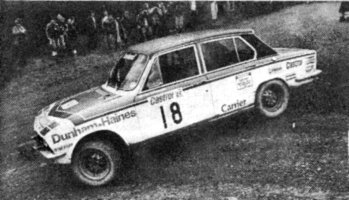
"Terry Kaby brought his G1 Dolomite home in fifth place overall and won the Man of the Rally award"
The rally itself was based once again in Aberystwyth, a town whose sole advantage must be the number of beds which it can offer to rally crews and their supporters. Unfortunately there is nowhere else in the area of comparable size of facilities but I wouldn't exactly choose Aberystwyth for a gourmet weekend away, given the choice. The event started at 8am and finished at 5pm, with results being sorted out by 9pm, allowing plenty of time for the celebrations to begin and then continue into the small hours of the next morning.
On a rally such as this one begins to realise just how finely tuned the modern rally car is: not just in the engine compartment either, but as an overall competition machine designed to extract the maximum possible speed. This tuning is a combination of a healthy engine, the right tyres, perfect suspension, strong brakes and a driver in the right frame of mind. On a shorter event any one of these factors can be wrong but can be compensated for. If the wrong tyres are chosen on a short stage then the right tyres can be chosen for the next time through. On long stages this is just not possible. It takes only one slight error of judgment or mechanical slip-up to make the difference between winning and losing.

Tyres are the most obviously crucial factor. It is generally accepted that a Dunlop A2 tyre can be three seconds a mile quicker than a M&S, given the right conditions. But then, what are the right conditions? And besides that, the A2 is more prone to punctures. However well you are driving, a puncture is bound to bring disaster. Goodyear seem to work on this principle. While their tyres may be slightly 'off the pace' compared to the Dunlops, they do seem to be pretty well puncture proof. Of the leading runners on the Castrol 78, only David Stokes and Terry Kaby, both Goodyear runners, suffered no punctures at all.
ENTRY
The Castrol 78 was a superb rally, and there can be no doubt that it would have attracted a very good entry in its own right. However there is also no doubt that it benefitted greatly, as it has done in past years, from its position in the rally calendar. The Lombard RAC Rally is just five weeks away and every factory team is now looking forward to that event. The chances for testing are all too rare, and the chances of testing in a competitive environment are rarer still. The Castrol 78 gives everybody a chance to run over some of the stages that will be absolutely crucial to the result of the RAC.
There is one other important point about the timing of the rally. It comes at a point in the year when most National rally championships are coming to an end. Under one of the stupid complications of the CSIn's International licencing system, an International licence holder can't take part in a National event in a foreign country. Thus, all those who take part in the Castrol 78 have to hold UK International licences. Effectively, they all become UK residents for the rest of this year.
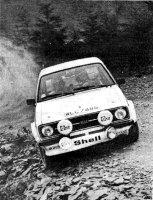
"Ari Vatanen lead for the first half of the event but a puncture and then a short excursion down a fire break dropped him to second."
The Ford strike continues and so still affects all the Escort entries from the factory. The drivers however still need the practice and so they all made private arrangements to compete on the event. Ari Vatanen had no problem, his entry was made and serviced by David Sutton. Bjorn Waldegaard was in slightly deeper water. He borrowed the same car that Hannu Mikkola had run on the Lindisfarne and arrived at the start without a proper service crew. With centralised servicing, it was easy to arrange tyre changes from Dunlop and he borrowed such tools as he did need from David Sutton's crew. When a damaged door had to be straightened out, it was Bjorn himself who wielded the hammer.
Russell Brookes had the worst problem of all. He borrowed a car from Jeff Churchill, but it was a car that hadn't seen much use lately and which had been sitting at the back of Peter Harrison's workshop. It needed an engine and a new back-axle, not to mention such basics as wheels and tyres. Then car did make the start but that was it. The brake bias bar in the pedal box had rusted through and broke the first time that Russell tried to brake. He drove about 100 yards down the road and retired. "At least I've still never failed to start an event." was his remarkably cheerful retort. From Team Toyota Europe came the two Toyota Celicas for Jen-Luc Therier and Lief Asterhag, both cars immaculately prepared but not really in with a chance of an overall placing. The team were quite adamant that they had only come over to do some pre-RAC testing and check on such matters as brake balance and tyre choice. With the cars prepared to G2 specification and developing only 180bhp they were clearly expecting to be outpaced. As it was, they ran competitively all day and didn't have a single problem, killing off one worry that the gearboxes might not be strong enough for this type of competition.
Dotted in among this host of International stars were the Castrol/Autosport regulars, who found themselves fighting for points and overall placings. Before the rally, three drivers were level on 58 points, Malcolm Wilson, Jim McRae and Nigel Rockey. Nigel Rockey didn't start but McRae and Wilson looked pretty evenly matched.
McRae had the use of a full DTV Vauxhall Chevette, the twin-cam version, while his single-cam car was being lent to Graham Elsmore for the rally. Graham had 'won' his drive last year and was thoroughly looking forward to driving something other than a competitive Escort. Wilson had his own Escort RS1800, the one which he started the Lindisfarne in and which he has rebuilt since the Peter Russek accident. In theory a miracle and both men were determined to drive sensibly to score maximum possible points.
There were a couple of welcome reappearances on the scene. Brian Culcheth and Dealer Opel Team dusted off 'Big Magic', the G5 Opel Kadett, Andy Dawson brought out one of his new Datsun 160Js, though fitted with the twin-cam engine rather than the homologated single-cam version, and John Taylor and Phil Short were putting in some forest testing before the RAC. On Saturday morning, it could have been anybody's rally.
RALLY
Down the road at the Ystwyth stage it looked as though Ari Vatanen's form was going to hold him in good stead. The young Finn was five seconds faster than Bjorn Waldegaard and took an immediate lead. Most of the others got through unscathed but for Pentti Airikkala, the rally started badly. He clipped a tree stump with a front wheel of the Chevette, puncturing a tyre and knocking the front suspension out of alignment. On this stage he dropped just 15 seconds to the front runner but the long stage to come in Hafren was going to prove more difficult.
Hafren proved to be difficult for everybody. The early morning mist and fog hadn't cleared, indeed didn't clear virtually all day, only those who were absolutely confident of their memory could afford to take any risks. Vatanen again took fastest, with a little bit of help from his Ford-mate Waldegaard, although Waldegaard wasn't quite on the road at the time. In the fog Bjorn had misjudged a corner, ending up sitting on the outside bank with the engine stalled. Ari arrived at the same corner rather too fast, swung the tail wide and used Bjorn's car to help him get round. The already rather tired looking Waldegaard Escort now boasted a bent rear wing and door panel as well
.
Airikkala was next quickest through, some 45 seconds down and then the field tailed out below him. Graham Elsmore and Terry Kaby both set fast times, Kaby on his way to a quite incredible result in the Dolomite Sprint.
Graham Elsmore's time was partly due to a tow through the fog from John Taylor. For Taylor the stage was a nightmare. Just a couple of miles in from the start he picked up a puncture which he stopped to change. There were some 15 miles to go and it would have been impossible to drive on. He restarted just before Elsmore appeared on the scene, leading Graham through the fog until, just before the end of the stage, he again slid wide on a corner and bounced over two hidden tree stumps. The impact pulled the back axle out of the floor, leaving the Escort stranded n the stage. Eventually he managed to get the car out of the stage and to a service crew who had, by now, arrived at the stage finish. There they rebuilt the car, John deciding to run through the last two stages of the ally in order to get in some more testing.
Those same tree stumps also caught out George Hill, except that they caught the front suspension of George's Chevette rather than the rear. The left front wheel buckled back and he was out of the rally.
For most of the others, punctures were to play a vital role. Malcolm Wilson suffered a puncture for about nine miles, which dropped him back by over two Minutes, John Buffum had a puncture and a wheel break up which lost him about four minutes and Brian Culcheth had an even more disastrous puncture. His was near the start of the stage and he stopped to change it, only to find that the jack didn't work properly. By the time that he finally got the car off the round and the wheel changed, he had lost over six minutes.
So, with two stages and just over 30 minutes of rallying gone, Vatanen led from Airikkala, Elsmore and Dawson. Andy was well pleased with his Datsun, despite the fact that the rear drum brakes were over-heating rather badly and was obviously hoping for a reasonable result. In the private Vauxhall battle, McRae was trailing Elsmore much to his consternation, though he did have the excuse that the engine was overheating badly and he was having to ease off. The service crew tried cutting the front spoiler away but it didn't seem to help much.
Terry Kaby lead the G1 battle, with John Cleary struggling after a rear brake pipe had burst, and Peter Clarke and John Nicol his nearest challengers.
The eight miles of Pantperthog followed after an early break for lunch in Machynlleth. Waldegaard's chapter of disasters continued with a puncture on this ne and then punctures on the next two stages as well. The net result of it was that he never really worked himself into the swing of things and failed to figure at all in the leading stage times.
Graham Elsmore picked up a puncture which dropped him back by 30 seconds and John Buffum's luck was no better. He stopped on the stage and collected a maximum penalty which meant that, even with some brilliant driving in the later stages, he wasn't able to climb back above 24th place.
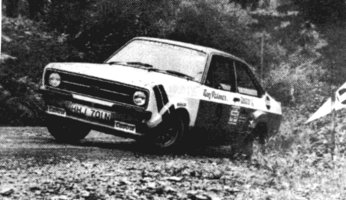
"The two young hopefuls were at it again, Malcolm Wilson (above) overcame an early puncture to finish third. Graham Elsmore (below) adapted very quickley to his borrowd Chevette and finished fourth."
The nastiest incident on Pantperthog though concerned Willie Rutherford. The little Mazda was running smoothly through a very fast left-hander when, quite without warning, things started to go wrong. "I was looking up the track, out of the bend, when suddenly the car started to run wide," was how Willie described it. "One minute I thought we were safely out of the bend and the next minute we were rolling away down the hillside. I simply can't understand it. The car was under control."
An explanation came later when the service crew went to recover the car. The Panhard rod had broken clean in half, leaving the rear suspension to float around totally uncontrollably. Interestingly enough both the DTV Chevettes also had Panhard rod trouble over these stages when the mounting bushes worked loose.
Vatanen was quickest on Pantperthog and also on the first Dyfi stage but it all started to go wrong from that moment on. On the second Dyfi he had three separate problems. Firstly the gearlever came away in his hand, making gear changing something of a problem, secondly he picked up a puncture, and thirdly he put the Escort down a firebreak for just under a minute. Airikkala had a clear run through and jumped forward into the lead.
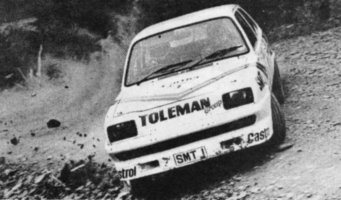
That firebreak was to prove something of a bogey for it also caught out Tim Brise. Tim had been having a good run and was lying fifth. When he arrived at the firebreak he had already had problems. A miscalculation of the miles involved meant that he was low on fuel and had just switched over to his reserve tank. The fuel pump wasn't working properly and the engine just didn't have enough power to pull him out of the mire. By the time that the spectators had pulled him out, he was out of the running and out of fuel. He decided to retire. Coming out of Dyfi there was still everything to fight for. McRae had closed to within two seconds of Elsmore, Airikkala was just nine seconds ahead of Vatanen. Malcolm Wilson had fought back brilliantly from his puncture, setting the quickest time on Dyfi Main and was up to fourth place. Dawson still held third. Ahead there was the longest Hafren stage, well over 22 miles and the shorter climax at Ystwyth. It was clear that Hafren would be the deciding test.
It was here that tyre choice became important. In the morning Hafren had been slippery and nasty, perhaps M&S would be more suitable than A2. The two Escort drivers, Vatanen and Waldegaard, went for M&S, Airikkala stayed on A2. Dawson changed from an A2 type to an M&S, Wilson stayed on A2. Despite a puncture for the last four miles Airikkala took another three seconds off Vatanen; Dawson dropped so far off the pace that he dropped three places in the running order, finishing sixth overall.

Amazingly, or perhaps because he had John Brown sitting beside him, John Buffum was quickest through the stage, three seconds quicker than Airikkala. Others were not so fortunate. Jim McRae punctured just at the start of the stage and had to stop to change the wheel. Then, halfway through the stage, the clutch packed up, forcing him to drive this one and the next without a proper gearchange. In similar problems was Terry Kaby, holding an incredible fifth place but also with clutch trouble for the last two stages.
And so the last stage of this marathon was reached. Pentti knew he had it in the bag; Ari had the speed but not the tyres. Through the six miles of Ystwyth, the Vauxhall was once again quicker than the Escort, this time by two more seconds. The final gap, after over 100 minutes of competitive rallying, was just 14 seconds. What will the battle be like on the RAC?
This then was a revival for the Vauxhall camp. Elsmore brought the single-cam car home in fourth place, a great effort for his first drive in the car, and McRae was back down in eighth but had showed well. His only real regret was that he hadn't scored enough Castrol/Autosport championship points. Wilson's third place, and first registered contender gives him a four point lead and a margin in to the last round. Even so, nobody can afford to make a mistake and even David Stokes, back in third in the series, could still win. It all hangs on the Wyedean on November 4.

